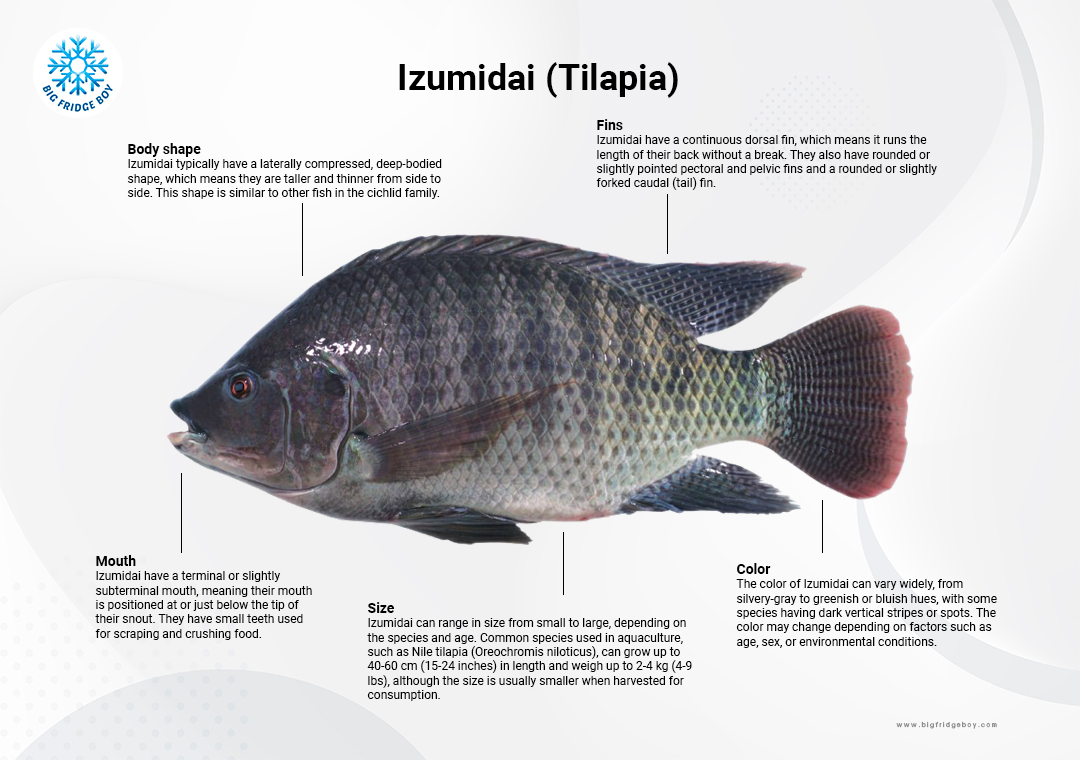'Izumidai' The [Best Budget-Friendly] Choice for Sushi&Sashimi

Izumidai (also spelled as Izumi-dai) is a term used in Japanese cuisine, particularly in sushi and sashimi dishes. It refers to a type of fish, specifically the tilapia. The tilapia is a freshwater fish native to Africa and the Middle East, but it has been widely introduced to other regions due to its adaptability and usefulness in aquaculture.
Izumidai is served as sushi or sashimi, with the fish being sliced into thin pieces and served either over vinegared rice or on its own. It is typically considered a more budget-friendly option compared to other types of fish used in sushi, like tuna or salmon, and may not have the same level of prestige or flavor as those fish. Nonetheless, it can still be a tasty and satisfying option for sushi lovers.
The scientific name for tilapia, which is referred to as Izumidai in Japanese cuisine, varies depending on the specific species. Tilapia belongs to the family Cichlidae and the genus Oreochromis. Some common species of tilapia used in aquaculture and for consumption include:
- Oreochromis niloticus - Nile tilapia
- Oreochromis aureus - Blue tilapia
- Oreochromis mossambicus - Mozambique tilapia
These species, among others, are commonly referred to as tilapia, and their adaptability, rapid growth, and disease resistance make them popular choices for aquaculture around the world.
History
The term "Izumidai" specifically refers to tilapia when used in the context of Japanese cuisine, such as sushi or sashimi dishes. However, the history of tilapia dates back thousands of years, with roots in Africa and the Middle East.
Tilapia is one of the oldest farmed fish species in the world, with evidence of their cultivation dating back to Ancient Egypt around 2500 BCE. Tilapia were prized by the Egyptians for their ability to reproduce quickly and their resistance to diseases, making them an ideal candidate for aquaculture.
In the following centuries, the farming and consumption of tilapia spread across Africa and the Middle East, becoming an important protein source in many local diets. The fish were introduced to other parts of the world during the 20th century, including Asia, South America, and the United States. Due to their hardiness and adaptability, tilapia have become one of the most widely farmed fish species globally, with China being the largest producer.
As for Izumidai's specific introduction to Japanese cuisine, it is not entirely clear when tilapia first made its way to Japan. However, it is likely that the increasing popularity and availability of the fish, combined with Japan's long history of sushi and sashimi, led to the incorporation of tilapia into these dishes. Izumidai is generally considered a more affordable and less prestigious option compared to other fish like tuna or salmon, but it still enjoys popularity in sushi and sashimi dishes, especially for budget-conscious consumers.

Appearance
The appearance of tilapia can vary somewhat depending on the species, but there are some general characteristics that are common among them:
- Body shape
Tilapia typically have a laterally compressed, deep-bodied shape, which means they are taller and thinner from side to side. This shape is similar to other fish in the cichlid family. - Size
Tilapia can range in size from small to large, depending on the species and age. Common species used in aquaculture, such as Nile tilapia (Oreochromis niloticus), can grow up to 40-60 cm (15-24 inches) in length and weigh up to 2-4 kg (4-9 lbs), although the size is usually smaller when harvested for consumption. - Color
The color of Tilapia can vary widely, from silvery-gray to greenish or bluish hues, with some species having dark vertical stripes or spots. The color may change depending on factors such as age, sex, or environmental conditions. - Fins
Tilapia have a continuous dorsal fin, which means it runs the length of their back without a break. They also have rounded or slightly pointed pectoral and pelvic fins and a rounded or slightly forked caudal (tail) fin. - Mouth
Tilapia have a terminal or slightly subterminal mouth, meaning their mouth is positioned at or just below the tip of their snout. They have small teeth used for scraping and crushing food.
Habitat
Izumidai, referred to as Tilapia in Japanese cuisine, are native to Africa and the Middle East. They are generally found in freshwater habitats such as lakes, rivers, ponds, and reservoirs. Tilapia are highly adaptable and can thrive in various environments, including habitats with varying water temperatures, salinity levels, and oxygen concentrations.
Tilapia prefer warm waters, with an optimal temperature range between 25-30°C (77-86°F). They can survive in temperatures as low as 12°C (54°F) and as high as 40°C (104°F), although growth rates and reproductive success may be affected at extreme temperatures.
They can tolerate brackish waters, but they are not a marine species and generally inhabit freshwater environments. Tilapia are omnivorous, feeding on a variety of food sources, including algae, aquatic plants, insects, and small fish.
In addition to their natural habitats, Tilapia are widely cultivated in fish farms around the world, including those in Asia, South America, and the United States. The fish are kept in ponds, cages, or tanks, where water conditions and food supplies can be carefully controlled to optimize growth and overall fish health.

Taste
The taste of Izumidai, or tilapia, is generally considered mild and delicate. Its flavor profile is subtle and less pronounced than other fish species commonly used in sushi or sashimi, like tuna or salmon. Here's a deeper look at the taste and texture characteristics of Izumidai:
- Flavor
Izumidai has a mild, slightly sweet flavor with a hint of earthiness. This mild taste makes it a versatile fish that can easily absorb the flavors of seasonings, marinades, or accompanying ingredients. The taste of Izumidai can vary depending on factors such as its diet, habitat, and freshness. Farm-raised Izumidai may have a more consistent and milder flavor than wild-caught counterparts. - Texture
The texture of Izumidai is generally firm and slightly flaky. It has a relatively fine-grained, lean flesh, which gives it a smooth and tender mouthfeel when properly cooked or served raw as sushi or sashimi. The firm texture also helps the fish retain its shape when sliced thinly for sushi or sashimi. - Fat content
Izumidai is a low-fat fish, containing less fat than other species like salmon or tuna. This lower fat content contributes to its lighter taste and texture. It also means that Izumidai does not have the rich, buttery mouthfeel or the melt-in-your-mouth sensation that is characteristic of more fatty fish. - Odor
Fresh Izumidai should have a mild, almost neutral odor. A strong or fishy smell is an indication that the fish may not be fresh.
While Izumidai may not be sought after as some other types of fish used in sushi and sashimi, its mild flavor and delicate texture can make it an enjoyable and versatile option, especially for those who prefer budget-conscious diners.





